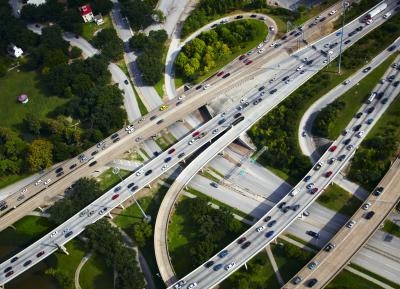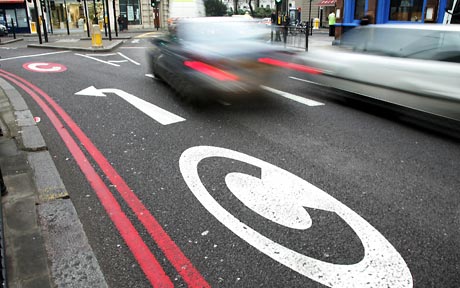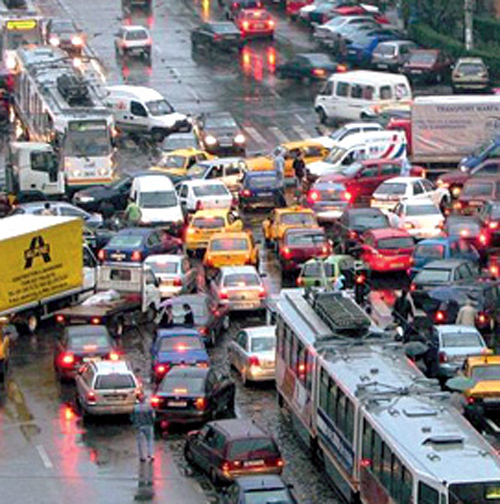Speaking bluntly: there’s no cure for congestion.
No, we’re not talking one of those bad, hacking coughs, that goes with the congested lungs of your wizened and blackened ex-smoker’s body here, we are talking the lungs of a much more important organism than you. We’re talking about the life of a city here. And with congestion in a city, there’s no cure at all.

The Stephen Joyce road brigade, that firmly believe that the more roads you can build will help to alleviate the present problem of congested roads, are plain and simply wrong. Current traffic logic / lore dictates a list of things to do when traffic gets badly congested:
Widening Roads; Speeding up intersections; Building More Roads.
And sadly, all of these are bunk.

Widening existing roads just means one thing: more cars can fit on that piece of road. The traffic isn’t going to go any faster than before, as all the traffic that was there before, is still there now. If anything, traffic may go a little slower, as there are now more cars. It is well known that widening a section of road from 1 lane to 2 lanes will not in itself work, but merely move the congestion point along. Unless a road is 2 lanes all the way from start to finish, traffic “planning” is just going to move the knot of congestion around. The congestion hasn’t gone, it is now just all around us.
Speeding up intersections is the next trick in the armoury of the intrepid traffic planner. Adding extra fast lanes in at roundabouts is a common aim, with central hub for people going sedately round corners, and whizzy side lanes crunching cyclists into dust around the outside edge. There are some amongst us, those on foot, flipper, or on cycle, who would prefer that traffic went slower round corners, not faster, thank you.

Building More Roads is a classic. The thinking goes, that if your roads gets congested, then just go get another one. A bigger, wider, longer, faster one. A new one. But then Dunlop’s Law comes into play: “traffic expands to fill the space available”. The new road becomes just as congested as the old one. And… you’re back to square one again, only this time with more asphalt. Reducing traffic by building more roads is like screwing for virginity: it just doesn’t work that way.

What about road charging? London does a Congestion charge, doesn’t it? Worked there, didn’t it? Well, yeah, but nah. London’s charge is just over people entering the central city in cars from out in the burbs. The charge, at first 5 quid, later 8 quid, and now did I hear 25 quid, merely pushes the flow of traffic outside and around the city barriers. The centre gets better, the periphery gets worse. Ironically, those trapped within the cordon, are better off: less traffic around, so they can drive their car more. Would a Congestion Charge work here? Well, not really, or at least, not to the same extent. The thing is with Wellington, is that you really can’t go round the outside. There’s just 2 ways into town, and when both of them are blocked, then both of them are blocked. End of story.

So: time to think differently then.
The way to take control over congestion therefore, is not to try to stop congestion, but to simply let it happen. If congestion is always kept just at bay, things don’t quite work. Tempers get frayed. Engines overheat. Traffic slows down. People keep on driving to their work, driving to the airport.
But let it happen fully instead. Let the traffic grind to a halt, with no hope of redemption.

Postscript: Article published before I had intended it to, so it was just a wee bit unfinished. Continues below.
With one proviso of course: that adequate public transport is in place before hand. If car-based traffic grinds to a halt and a decent high-speed public transport system isn’t in place first, then all hell breaks loose as everything stops. But if the city has taken the time and car and thought and consideration and, yes, money to install a quality, high speed, rapid public transport system that traverses the city, then the cars can grind to a halt, and the rest of the business can keep on working just fine.

Buses, trams, or light rail trains: they’ll all do fine.





i think a solution would be to artificially inflate the price of petrol by putting extra taxes on it.
oh wait…
good video on streets and congestion
Moving Beyond the Automobile: Road Diets from Streetfilms on Vimeo.
Good call! I’d quite happy re-route the 2.4billion of Wellington roading spending into public transport and see what happens…
There is a extraordinary meeting of the Council tonight to discuss the issues of Roading, called by the so-called Gang of Nine, as noted here on Scoop: http://wellington.scoop.co.nz/?p=33830
but on the other hand, there is also confirmation that the study of public transport has at last been confirmed as going ahead – that’s here on Scoop: http://wellington.scoop.co.nz/?p=33979
That says that :
“The Public Transport Spine Study is being carried out by Greater Wellington Regional Council, in partnership with Wellington City Council and the NZ Transport Agency. The study will assess the feasibility and merits of a range of long-term options for a high frequency, high quality public transport system between Wellington Railway Station and Wellington Regional Hospital, including possible connections to the north and south-east. Options investigated will include light rail and bus.”
They will be calling for tenders, which means that the almighty Traffic planners, so unbeloved of the Fish, will get to flex their intellectual muscle. Followed up later in May or June, next year.
What amazes me is that appliance stores seem to be the centre of the surburban universe at the weekend. It drives me mad going out at the weekend – why does everyone need to drive to the store and touch a fridge before they buy it?
Being able to buy more online would cut down on a lot of weekend congestion, if only more people trusted what they saw on the screen and didn’t need to go and fondle the chiller drawers. I used to buy a lot of things online in the UK and was amazed how little I could get when I came back here.
The other day I ordered groceries online with a delivery slot of 6-8pm and they arrived at 6.01pm. And the wine was already chilled. More people should do this. And if anyone from Progressives is reading, if you made the delivery charge half what it is (i.e less than the cost of the petrol it takes to drive to the supermarket) more people probably would.
Instead of sending the people to the goods we should be sending the goods to the people more efficiently, more cheaply and more reliably.
But I suspect the real problem is that not only are NZers inside their cars, but their cars are inside their heads. A huge mental shift is required…
Sadly the Gang of Nine won’t be reading the Fish or taking any notice of any mamby pamby overseas studies which conclude that you can’t treat congestion by building more roads or increasing capacity. The Eastern burbs are different right!? Only 4 lanes from my house to downtown will suffice thank you. I visited the airport today (by car, hoorah!) and was amazed by.
1. The sheer number of taxis assembled there. Is there any other airport in the world servicing the capital city of that country that doesn’t have decent public transport connecting it with the CBD?
2. The cars crawling along to flow through the drop off point. If you are basing your transport options for your airport on cars at least design properly for them.
3. Where is the assigned pick up point if, by neccessity you are picking someone up by car?
[…] Read also: There’s no cure for congestion […]